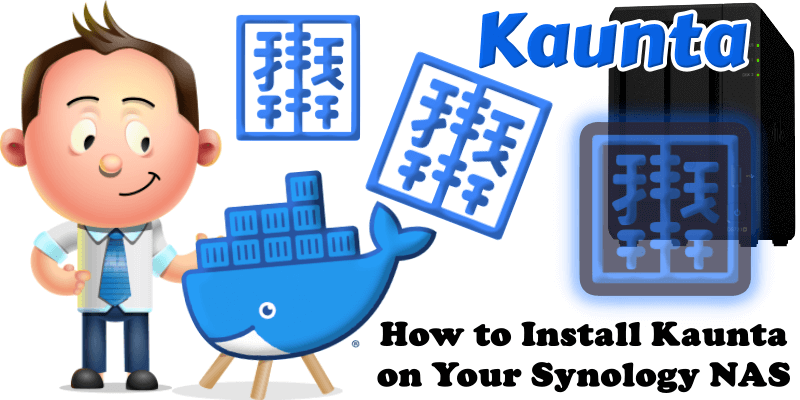
Kaunta is a lightweight, fast, privacy-centric web analytics tool in Go, offering a bloat-free alternative to Umami. It prioritizes user privacy with no cookies or invasive tracking, providing anonymized insights on visitors, pageviews, referrers, devices, locations, and real-time activity. It supports Umami’s API and schema for easy migration, includes MaxMind GeoLite2 geolocation, handles multiple domains with white-labeling via CNAME, and deploys as a single <10MB binary on Linux, macOS, Windows, or FreeBSD (amd64/arm64). The intuitive dashboard displays overviews, top pages/referrers, device breakdowns, location maps, and live stats. In this step by step guide I will show you how to install Kaunta on your Synology NAS using Docker & Portainer.
This guide works perfectly with the latest Kaunta v0.36.0 release.
STEP 1
Please Support My work by Making a Donation.
STEP 2
Install Portainer using my step by step guide. If you already have Portainer installed on your Synology NAS, skip this STEP. Attention: Make sure you have installed the latest Portainer version.
STEP 3
Make sure you have a synology.me Wildcard Certificate. Follow my guide to get a Wildcard Certificate. If you already have a synology.me Wildcard certificate, skip this STEP.
STEP 4
Go to Control Panel / Login Portal / Advanced Tab / click Reverse Proxy. Follow the instructions in the image below.
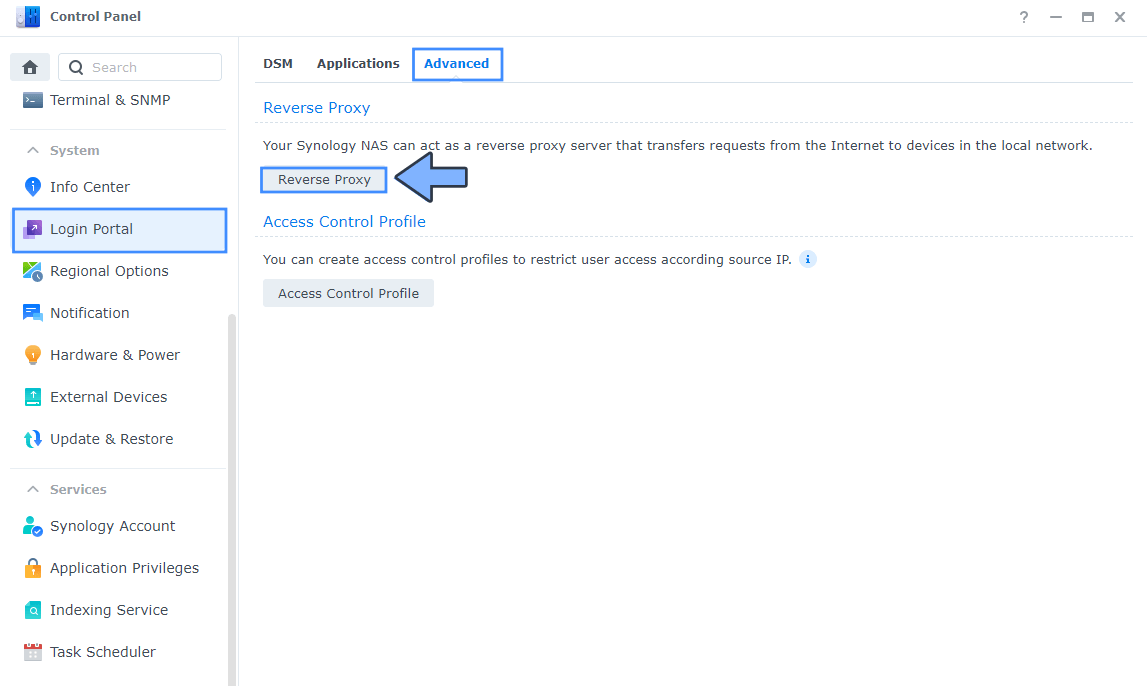
STEP 5
Now click the “Create” button. Follow the instructions in the image below.
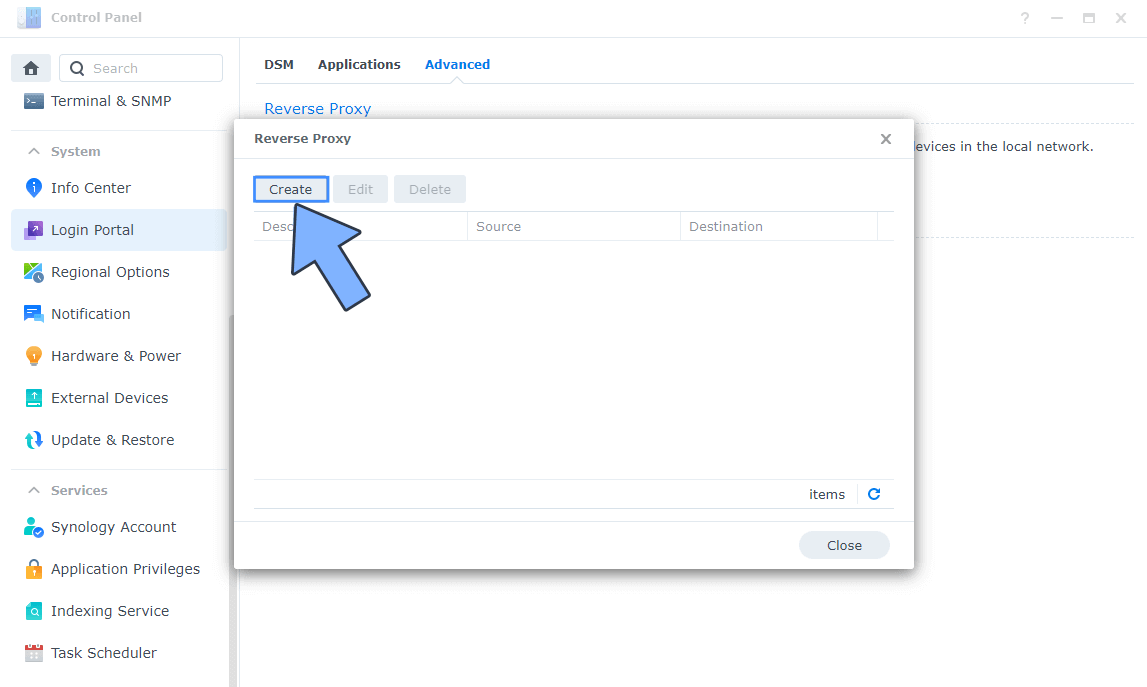
STEP 6
After you click the Create button, the window below will open. Follow the instructions in the image below.
On the General area, set the Reverse Proxy Name description: type in Kaunta. After that, add the following instructions:
Source:
Protocol: HTTPS
Hostname: kaunta.yourname.synology.me
Port: 443
Check Enable HSTS
Destination:
Protocol: HTTP
Hostname: localhost
Port: 3106
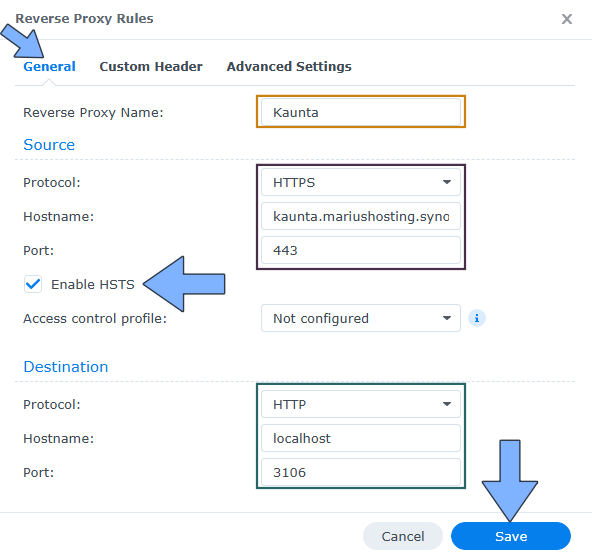
STEP 7
On the Reverse Proxy Rules, click the Custom Header tab. Click Create and then, from the drop-down menu, click WebSocket. After you click on WebSocket, two Header Names and two Values will be automatically added. Click Save. Follow the instructions in the image below.
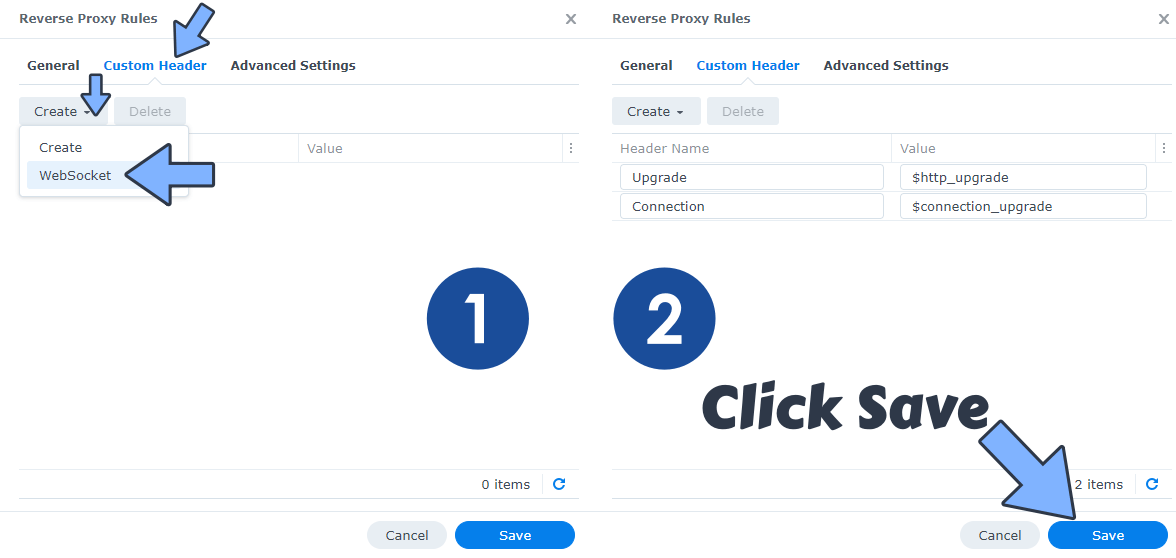
STEP 8
Go to Control Panel / Network / Connectivity tab/ Check Enable HTTP/2 then click Apply. Follow the instructions in the image below.
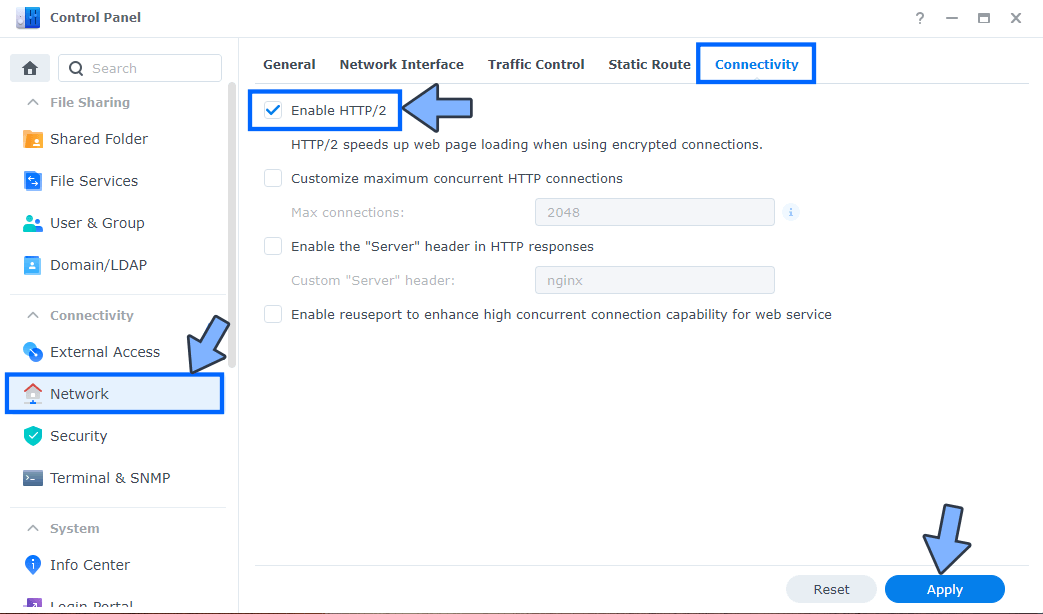
STEP 9
Go to Control Panel / Security / Advanced tab/ Check Enable HTTP Compression then click Apply. Follow the instructions in the image below.
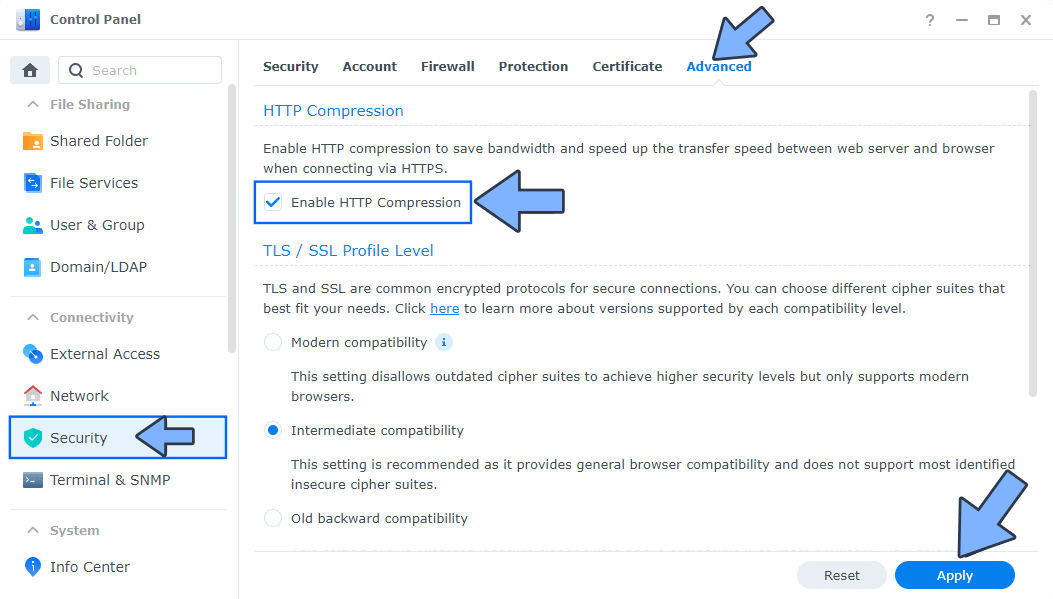
STEP 10
Go to File Station and open the docker folder. Inside the docker folder, create one new folder and name it kauntadb. Follow the instructions in the image below.
Note: Be careful to enter only lowercase, not uppercase letters.

STEP 11
Log into Portainer using your username and password. On the left sidebar in Portainer, click on Home then Live connect. Follow the instructions in the image below.
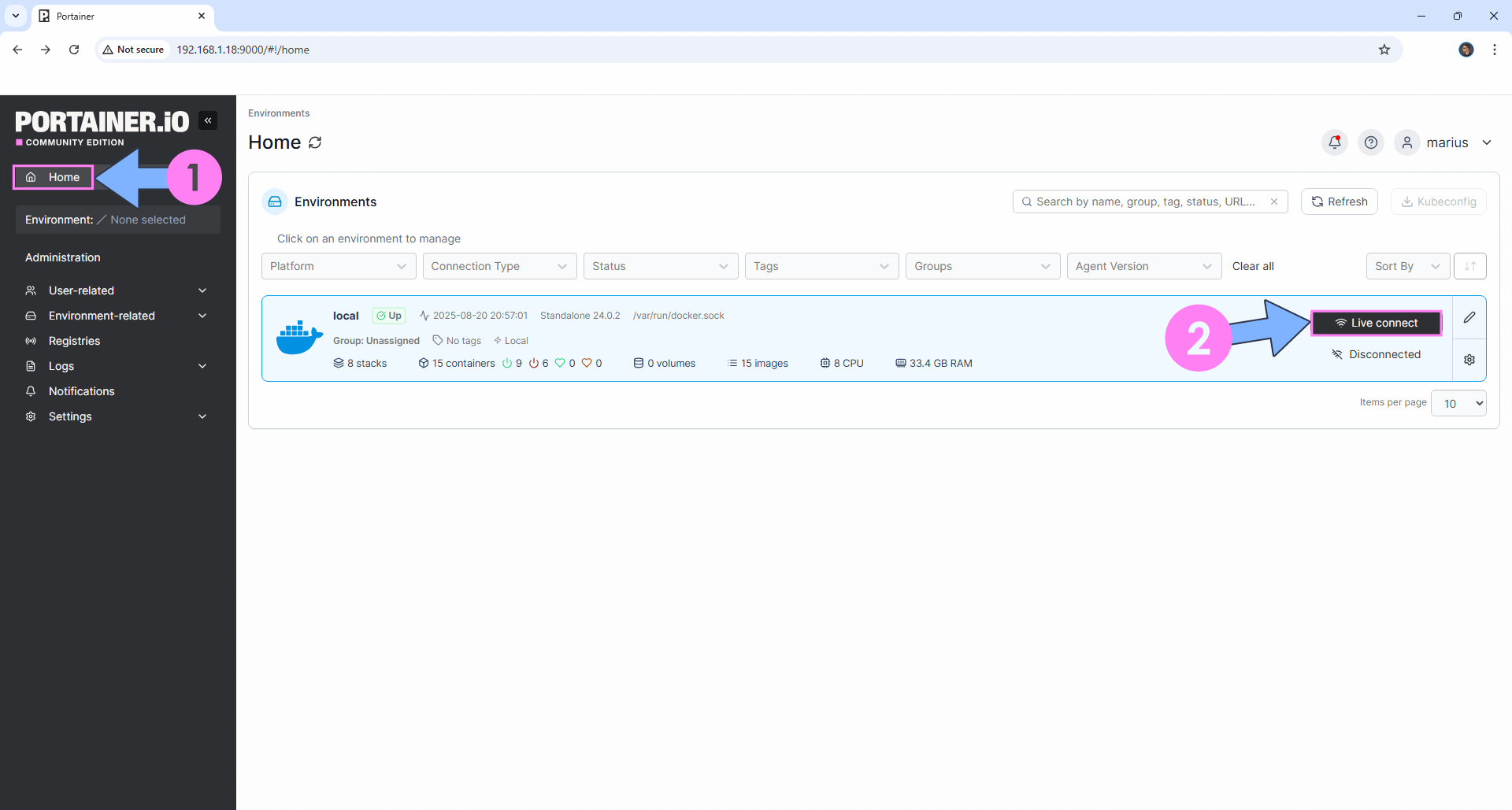
On the left sidebar in Portainer, click on Stacks then + Add stack. Follow the instructions in the image below.
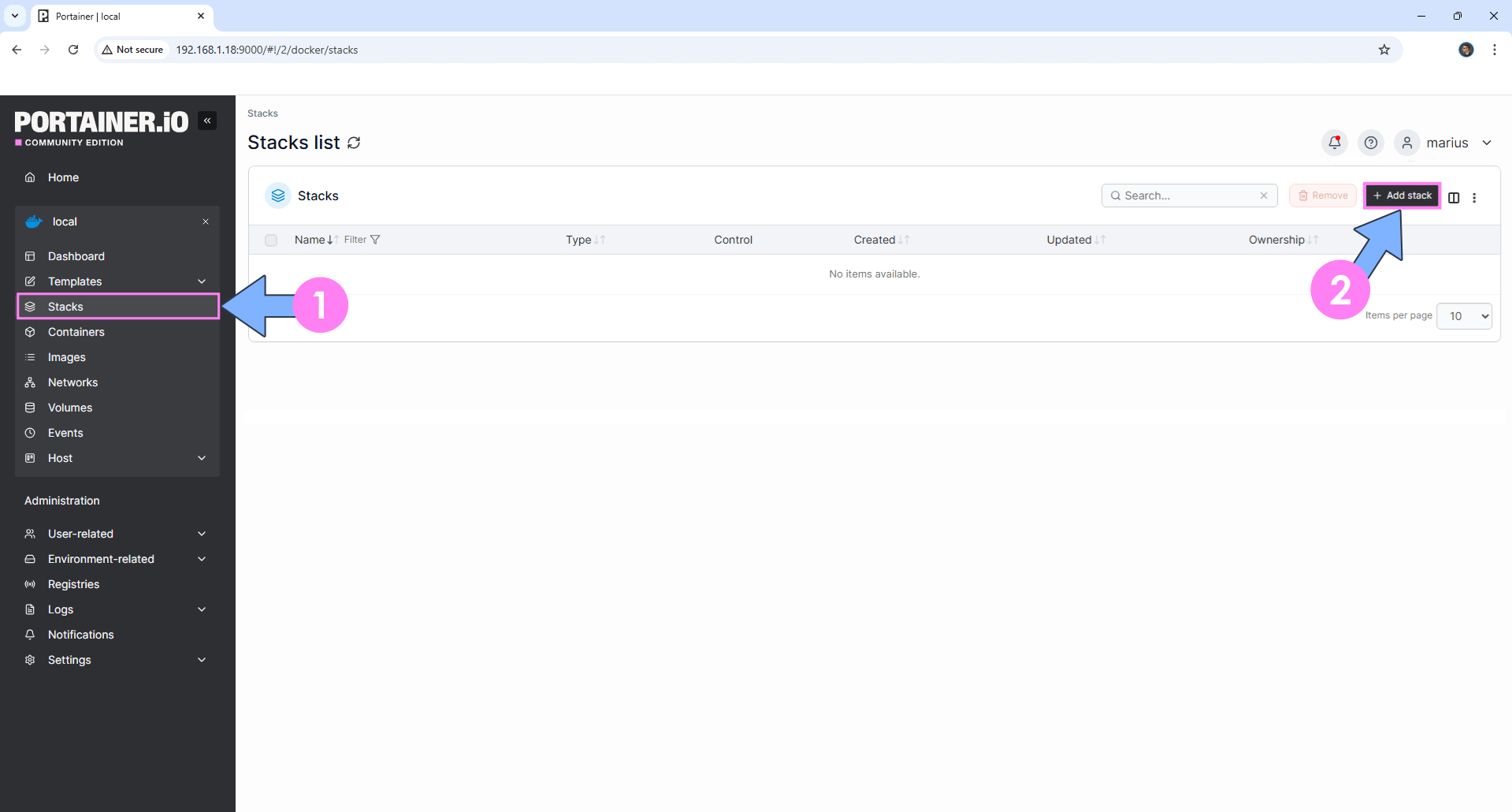
STEP 12
In the Name field type in kaunta. Follow the instructions in the image below.
services:
db:
image: postgres:17-alpine
container_name: Kaunta-DB
hostname: kaunta-db
security_opt:
- no-new-privileges:false
healthcheck:
test: ["CMD", "pg_isready", "-q", "-d", "kaunta", "-U", "kauntauser"]
timeout: 45s
interval: 10s
retries: 10
environment:
POSTGRES_DB: kaunta
POSTGRES_USER: kauntauser
POSTGRES_PASSWORD: kauntapass
volumes:
- /volume1/docker/kauntadb:/var/lib/postgresql/data:rw
restart: on-failure:5
kaunta:
image: ghcr.io/seuros/kaunta:latest
container_name: Kaunta
healthcheck:
test: ["CMD-SHELL", "nc -z 127.0.0.1 3106 || exit 1"]
interval: 10s
timeout: 5s
retries: 3
start_period: 90s
environment:
DATABASE_URL: postgresql://kauntauser:kauntapass@kaunta-db:5432/kaunta?sslmode=disable
PORT: 3106
TRUSTED_ORIGINS: localhost,192.168.1.18,https://kaunta.yourname.synology.me
ports:
- 3106:3106
depends_on:
db:
condition: service_healthy
restart: on-failure:5
Note: Before you paste the code above in the Web editor area below, change the values for TRUSTED_ORIGINS. Type in your own local NAS IP instead of 192.168.1.18 which is my own local NAS IP. Type in your own synology.me DDNS with https:// at the beginning that you have previously created at STEP 6. ⚠️Note: Remember to insert a comma between the local NAS IP and the DDNS synology.me.
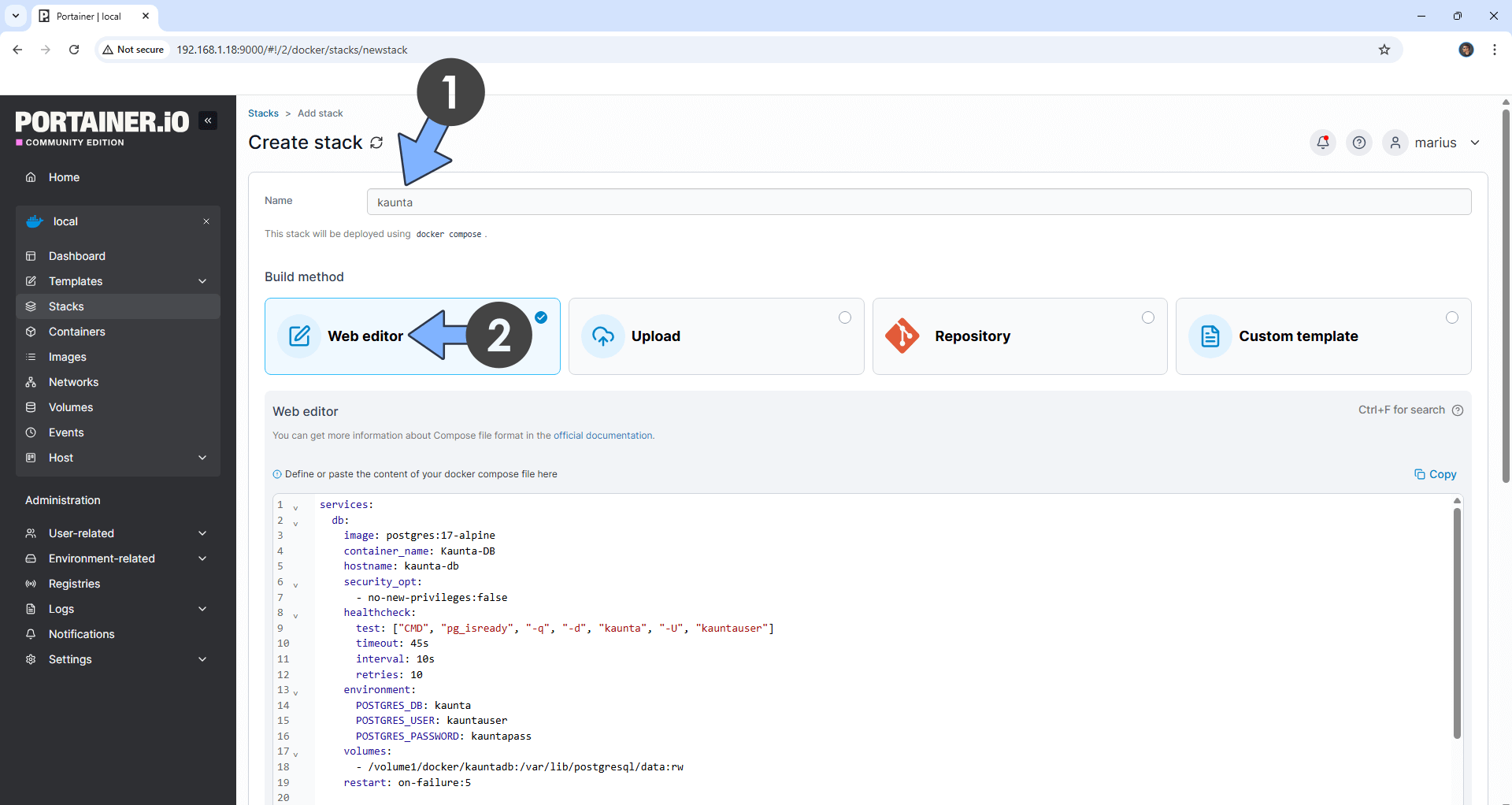
STEP 13
Scroll down on the page until you see a button named Deploy the stack. Click on it. Follow the instructions in the image below. The installation process can take up to a few minutes. It will depend on your Internet speed connection.
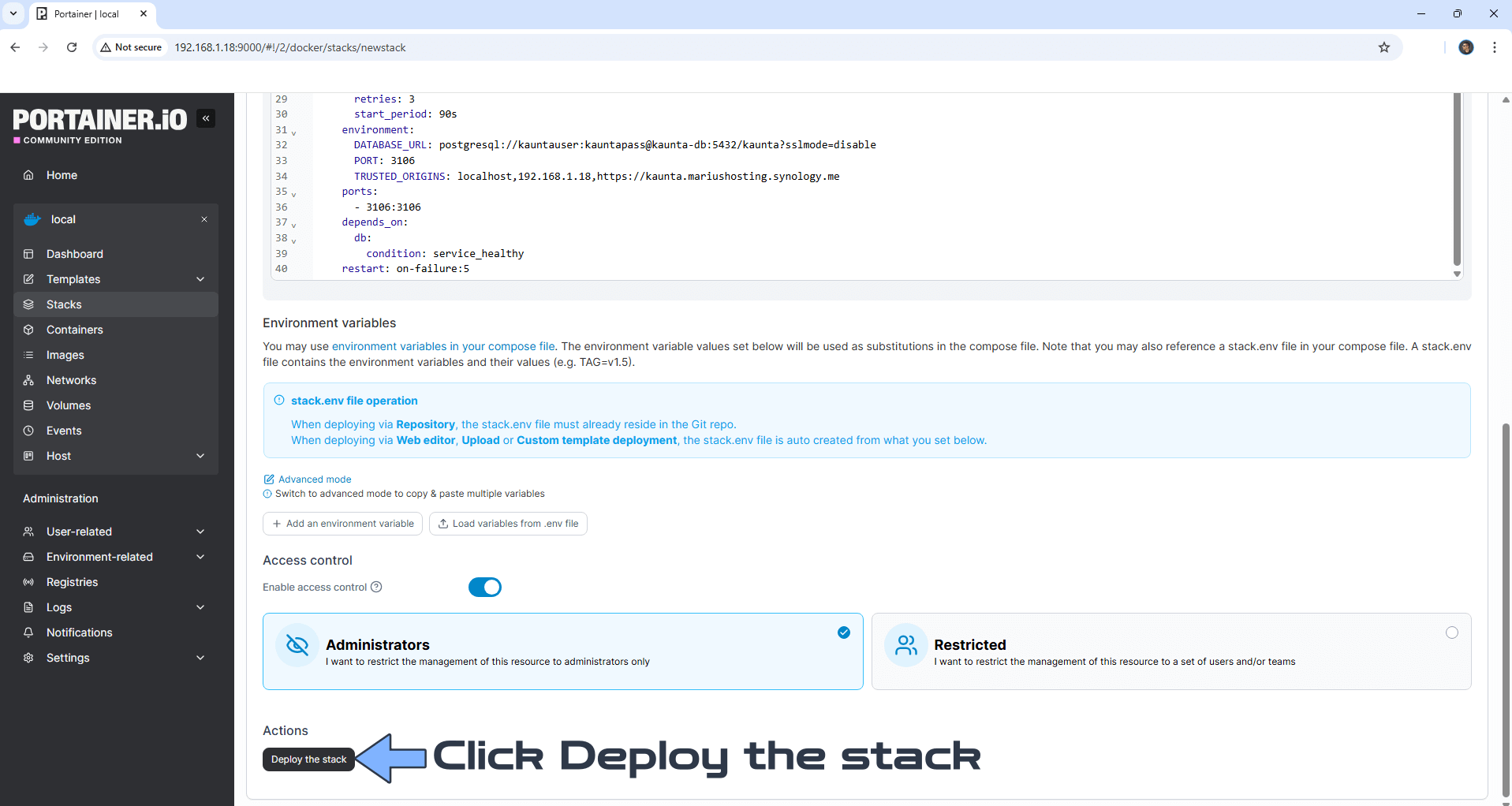
STEP 14
If everything goes right, you will see the following message at the top right of your screen: “Success Stack successfully deployed“.
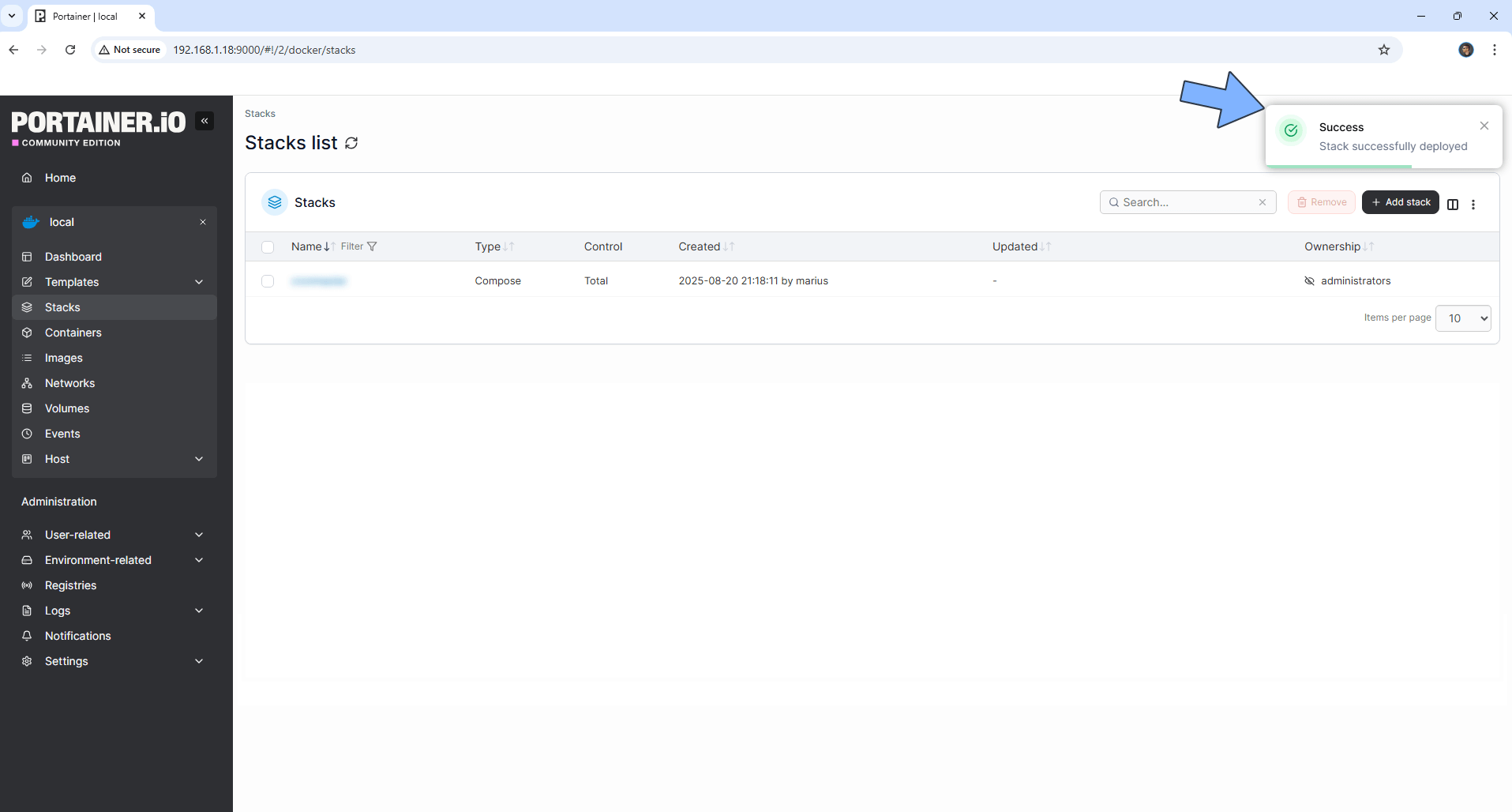
STEP 15
🟢Please Support My work by Making a Donation. Almost 99,9% of the people that install something using my guides forget to support my work, or just ignore STEP 1. I’ve been very honest about this aspect of my work since the beginning: I don’t run any ADS, I don’t require subscriptions, paid or otherwise, I don’t collect IPs, emails, and I don’t have any referral links from Amazon or other merchants. I also don’t have any POP-UPs or COOKIES. I have repeatedly been told over the years how much I have contributed to the community. It’s something I love doing and have been honest about my passion since the beginning. But I also Need The Community to Support me Back to be able to continue doing this work.
STEP 16
On the left sidebar in Portainer, click Containers. Identify your Kaunta instance, then click on the little terminal icon. Follow the instructions in the image below.
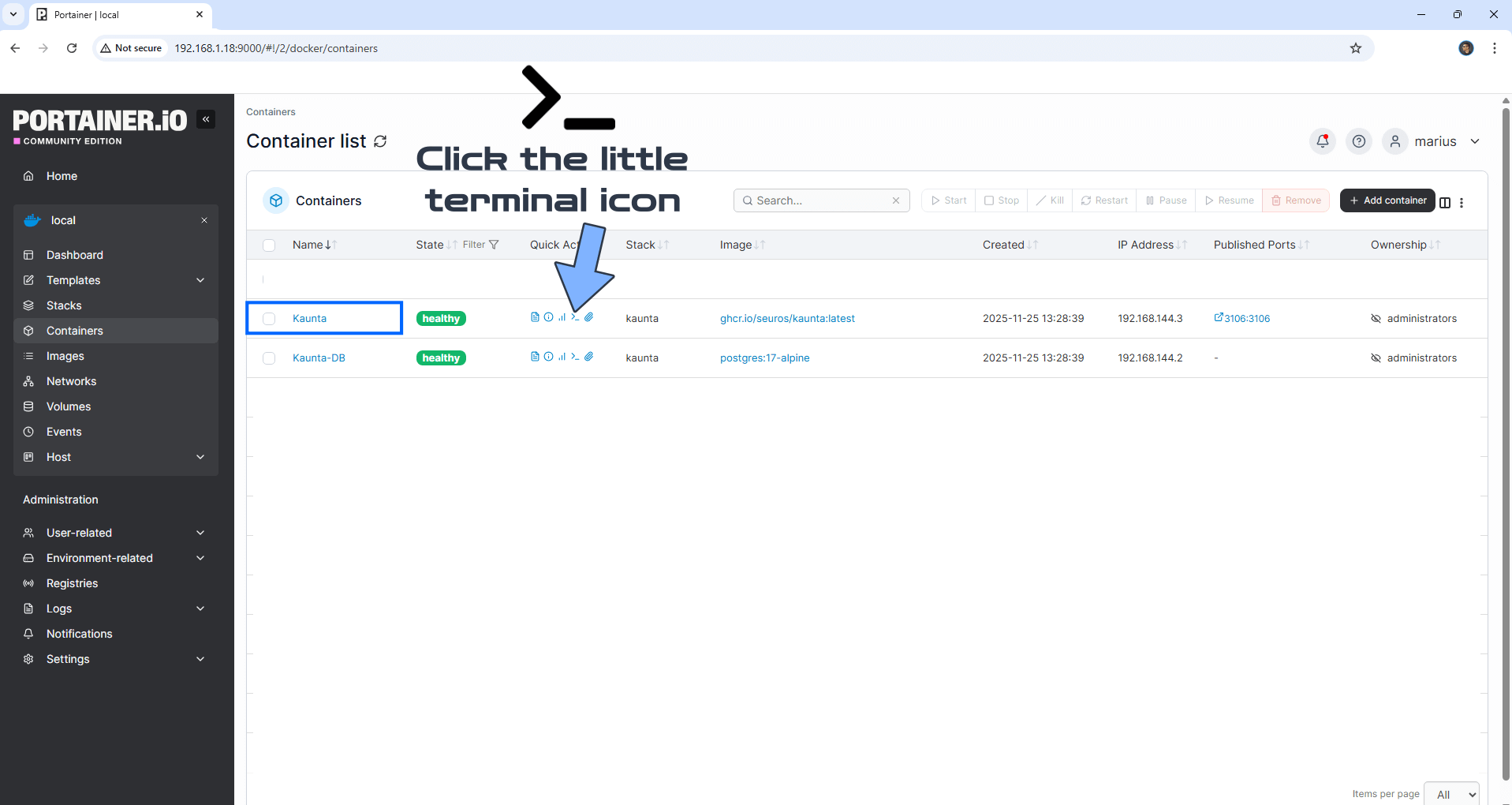
STEP 17
After you click on the little terminal icon at STEP 16, a new page will open. From the drop-down Command menu select /bin/sh then click Connect. Follow the instructions in the image below.
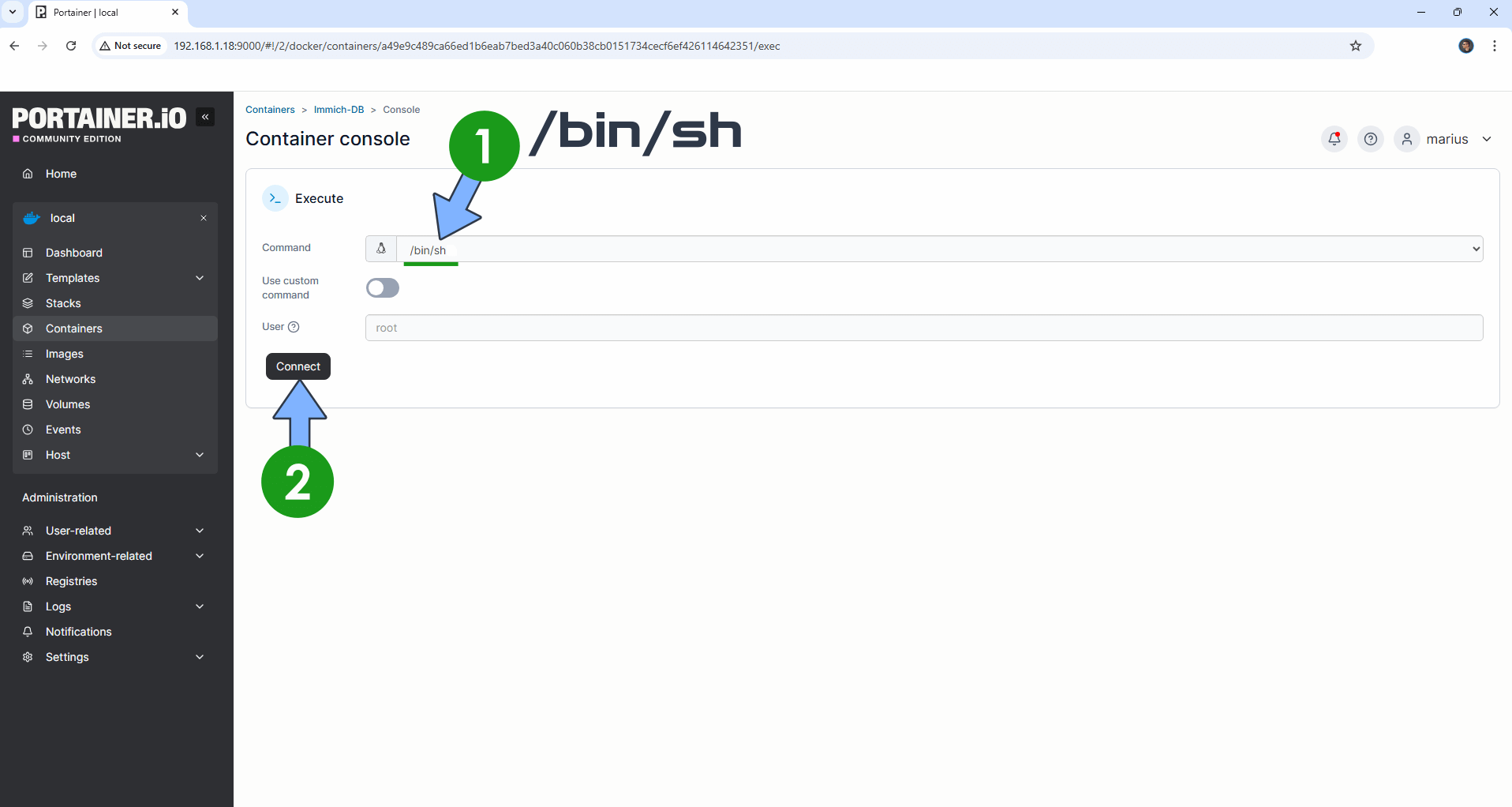
STEP 18
After you click Connect at STEP 17, a Console will open. Copy Paste the code below and follow the instructions in the image.
kaunta user create marius
Note: Before you paste the code above in the Console area below, change marius with your own name. You will need this Username later at STEP 30. Press enter on your keyboard to confirm.
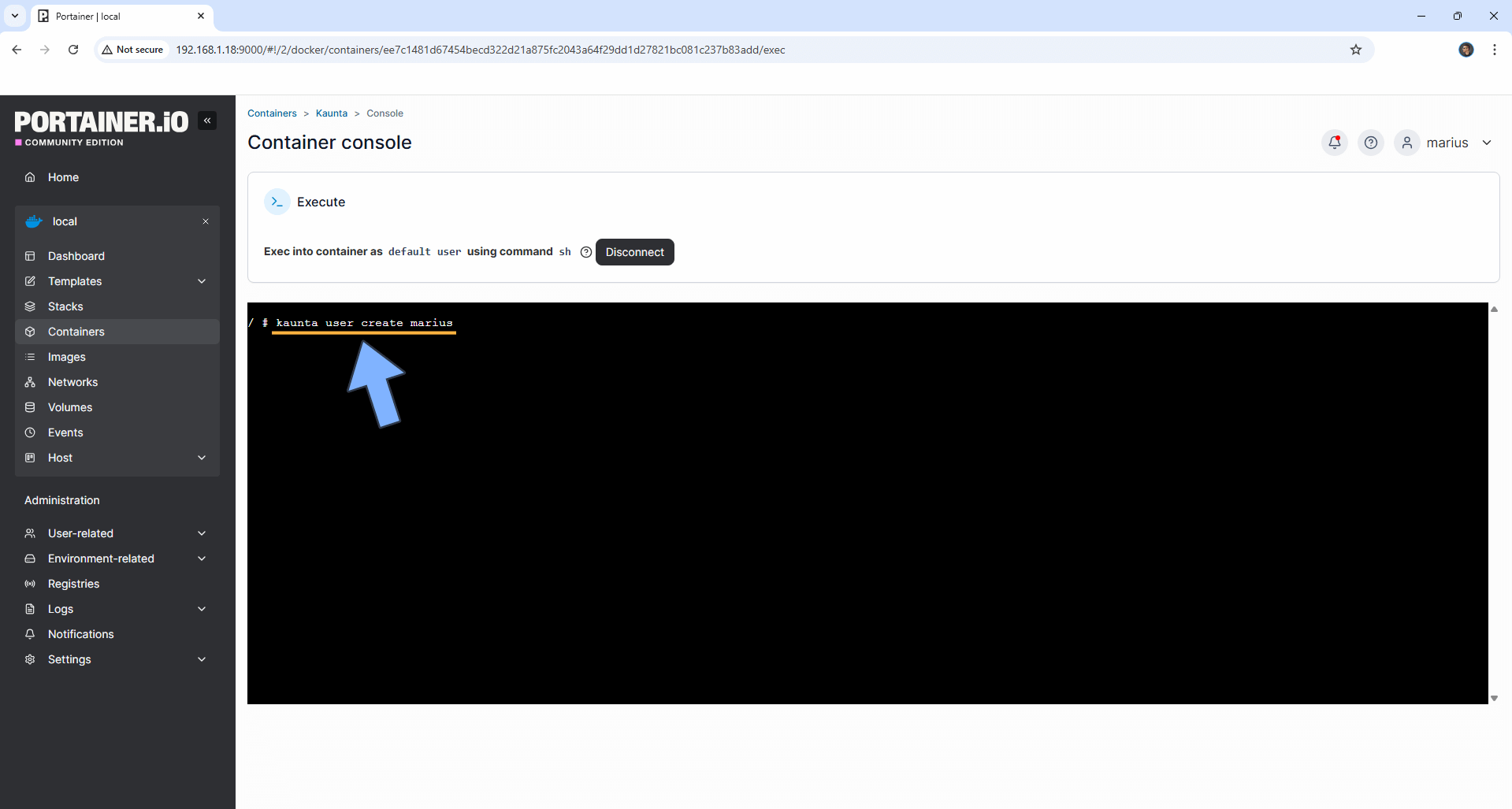
STEP 19
Type in your own Full Name then press enter on your keyboard. Follow the instructions in the image below.

STEP 20
Type in your own Password. ⚠️Before you go crazy with it. When you type in the password in the console, you will not see it. This is a normal behavior. You will need this password later at STEP 30. Press enter on your keyboard to confirm.

STEP 21
Confirm your Password. ⚠️Before you go crazy with it. When you type in the password in the console, you will not see it. This is a normal behavior. Press enter on your keyboard to confirm.
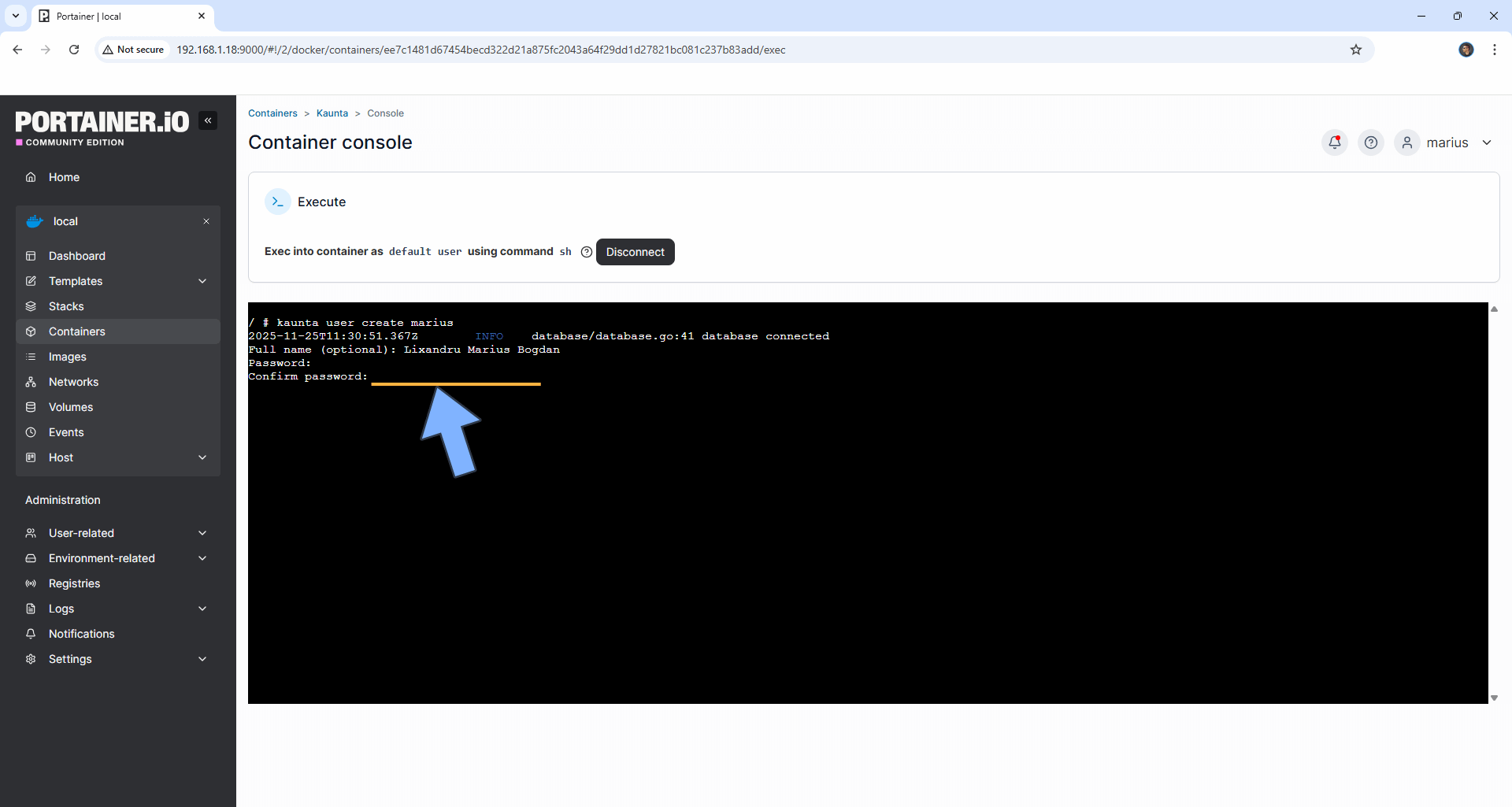
STEP 22
Your user is successfully created. Go straight to the next STEP.

STEP 23
Copy Paste the code below and follow the instructions in the image below.
kaunta website create mariushosting.com
Note: Before you paste the code above in the Console area below, change mariushosting.com with the domain name that you want to monitor. Press enter on your keyboard to confirm.
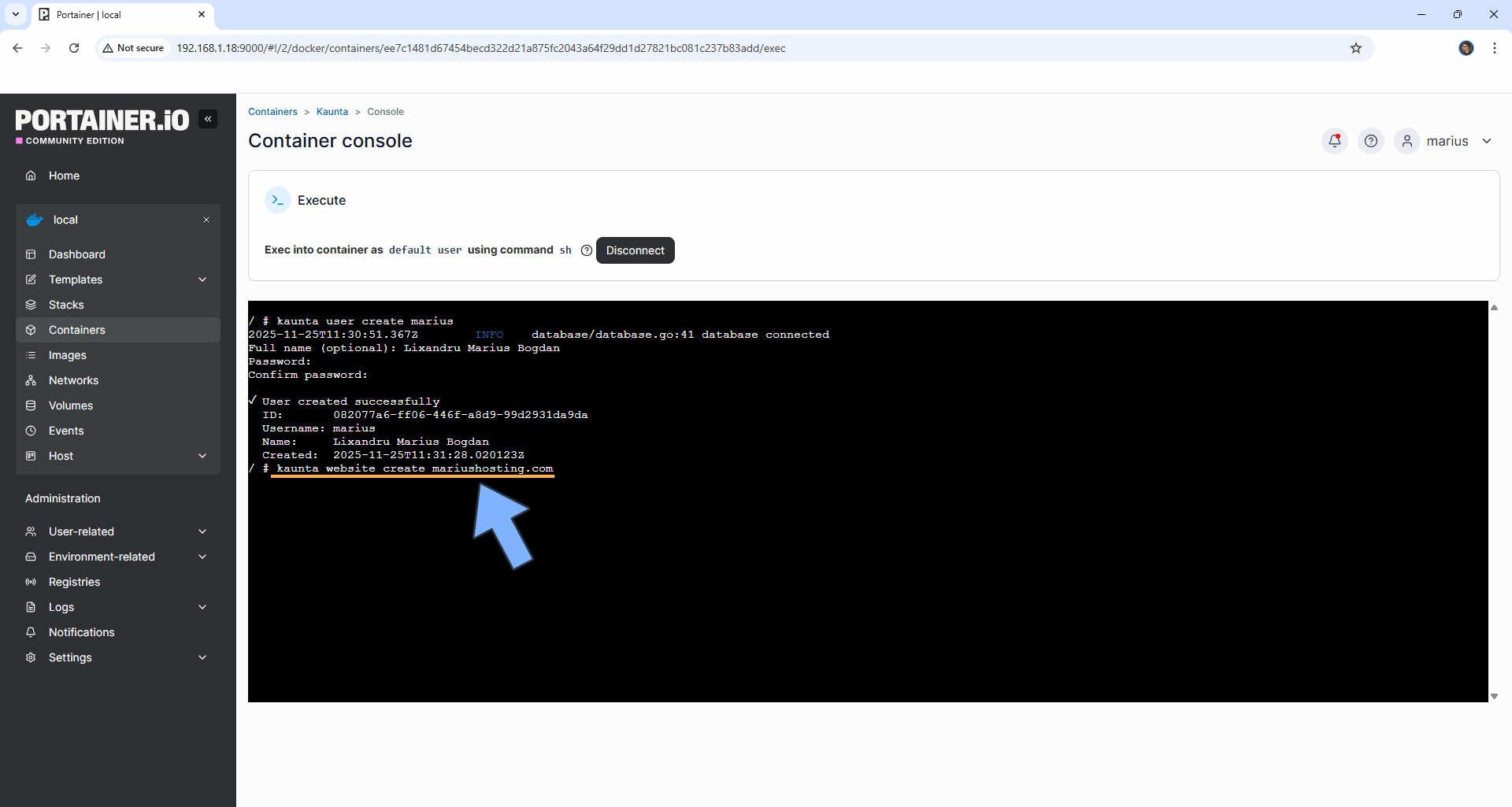
STEP 24
The domain has been successfully added. Copy the Tracking Code ID. You will need this code later at STEP 25. Follow the instructions in the image below.
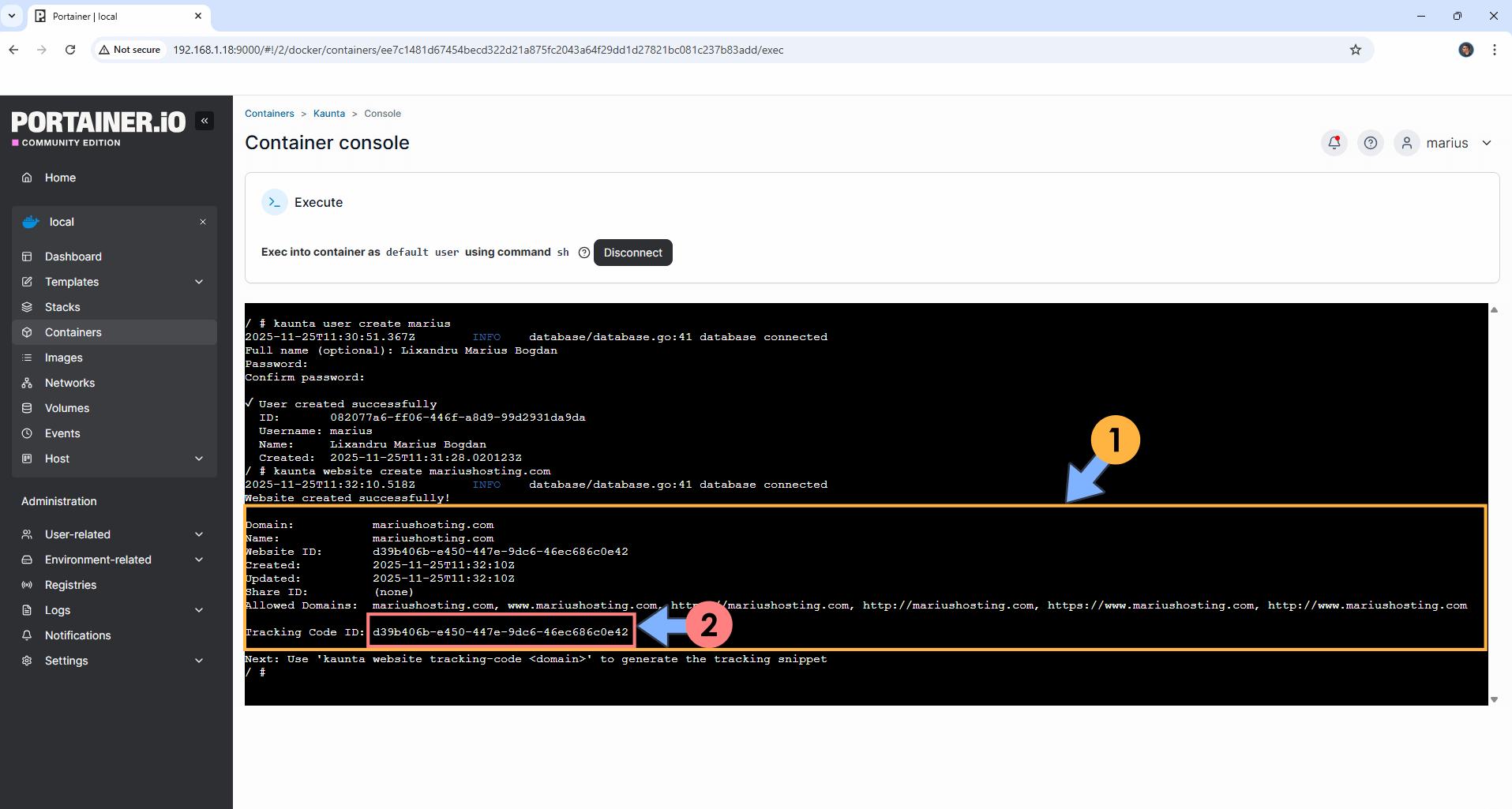
STEP 25
Copy Paste the code below and follow the instructions in the image below.
kaunta website d39b406b-e450-447e-9dc6-46ec686c0e42 kaunta.yourname.synology.me
Note: Before you paste the code above in the Console area below, change d39b406b-e450-447e-9dc6-46ec686c0e42 with your own Tracking Code ID that you have previously generated at STEP 24. Type in your own synology.me DDNS without https:// at the beginning that you have previously created at STEP 6. Press enter on your keyboard to confirm.

STEP 26
Your tracking ID code has been successfully added to your domain name. Go straight to the next STEP.
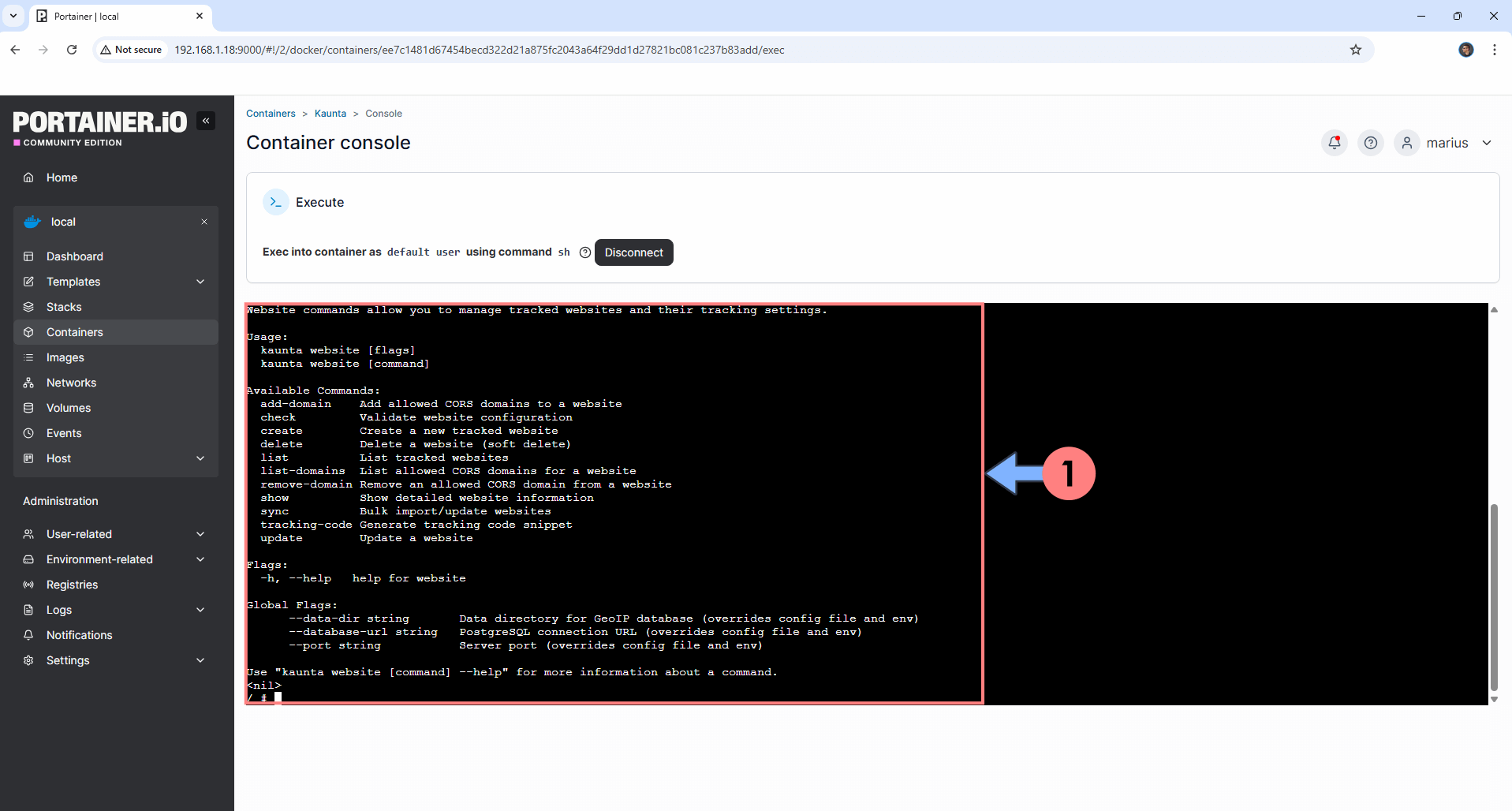
STEP 27
Download the kaunta.txt to check your script (click on the blue link below). Follow the instructions in the downloaded kaunta.txt script.
Paste your personal Kaunta Tracking code script that you have downloaded at STEP 27 on your website between the <head> and </head> tags of your site, then update your file. For example, I have a WordPress website hosted on a Synology NAS. If you have a WordPress website hosted elsewhere, know that the process is the same. Log into your WordPress admin Dashboard, click on the left sidebar on “Theme File Editor“, under Appearance. Select your theme then search for the header.php file. Paste your personal Kaunta Tracking code script in the header.php file between the <head> and </head> tags of your site, then update your file. Follow the instructions in the image below.
Note: You can add multiple websites following the same STEPS from STEP 23 to STEP 26.

STEP 28
🟢Please Support My work by Making a Donation. Almost 99,9% of the people that install something using my guides forget to support my work, or just ignore STEP 1. I’ve been very honest about this aspect of my work since the beginning: I don’t run any ADS, I don’t require subscriptions, paid or otherwise, I don’t collect IPs, emails, and I don’t have any referral links from Amazon or other merchants. I also don’t have any POP-UPs or COOKIES. I have repeatedly been told over the years how much I have contributed to the community. It’s something I love doing and have been honest about my passion since the beginning. But I also Need The Community to Support me Back to be able to continue doing this work.
STEP 29
Now open your browser and type in your HTTPS/SSL certificate like this https://kaunta.yourname.synology.me In my case it’s https://kaunta.mariushosting.synology.me If everything goes right, you will see the Kaunta main page. Click View Dashboard. Follow the instructions in the image below.
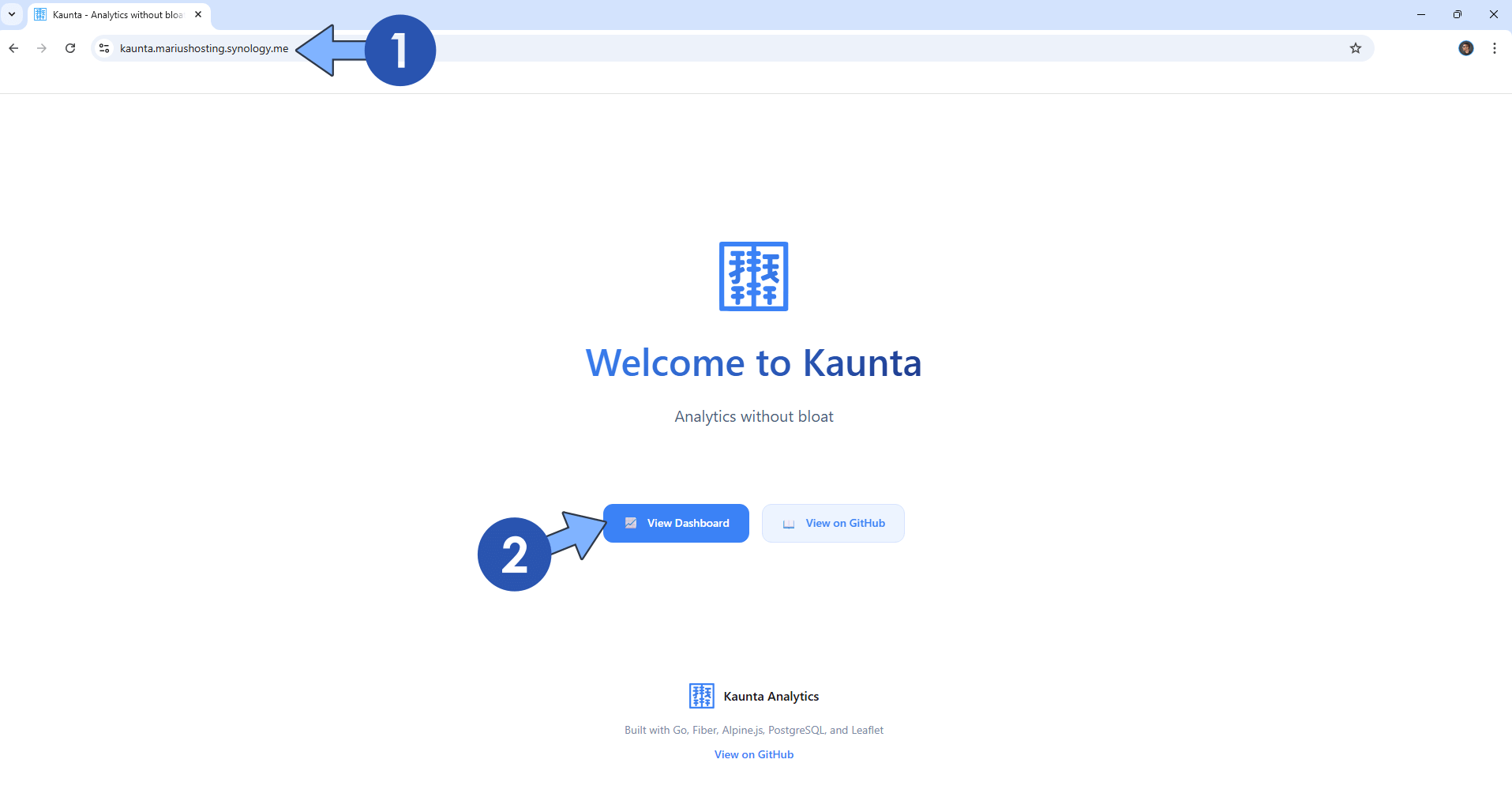
STEP 30
Type in your own Username and Password that you have previously added at STEP 18 and, respectively, STEP 20. Click Login. Follow the instructions in the image below.
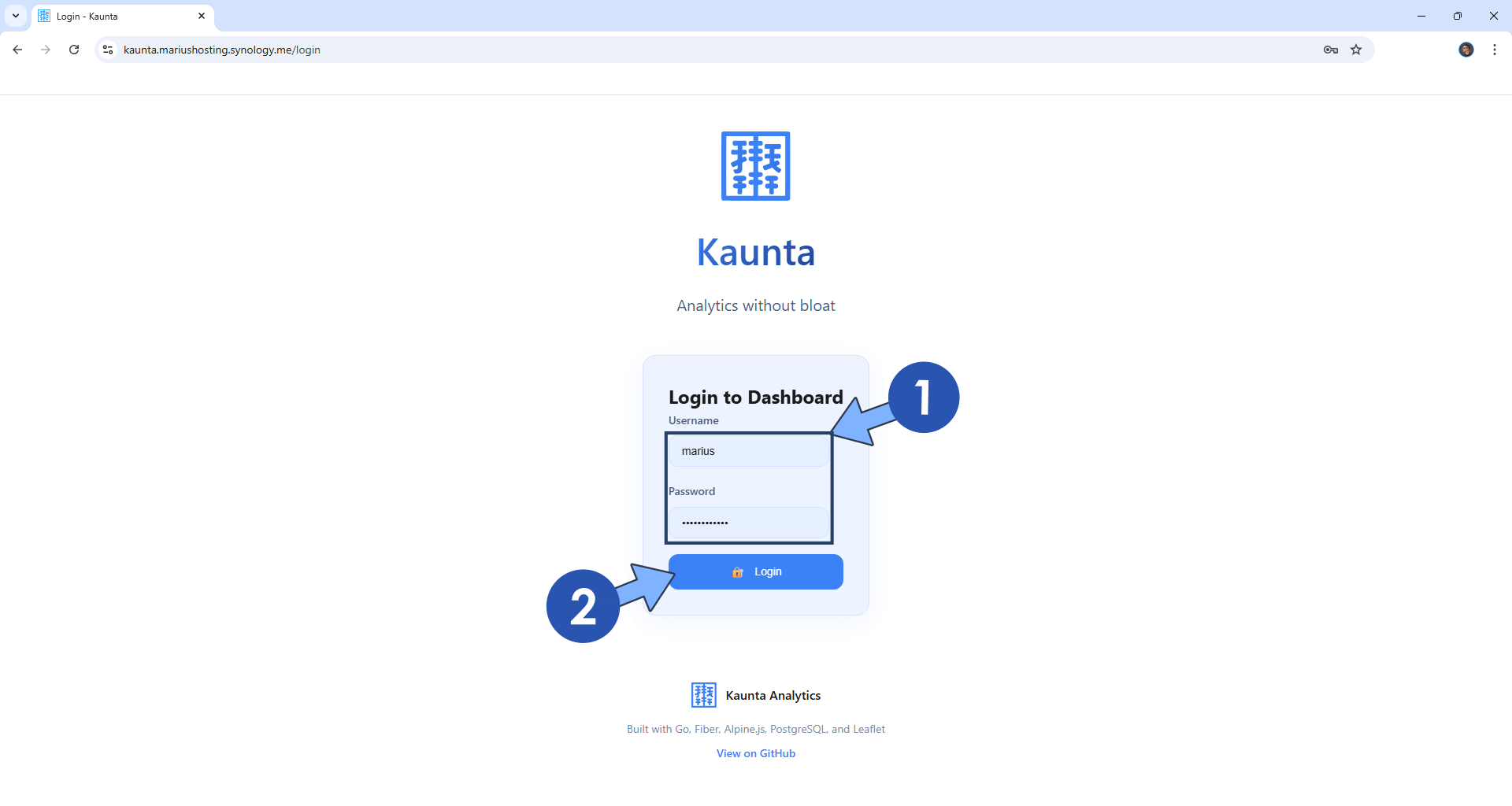
STEP 31
Your Kaunta dashboard at a glance!
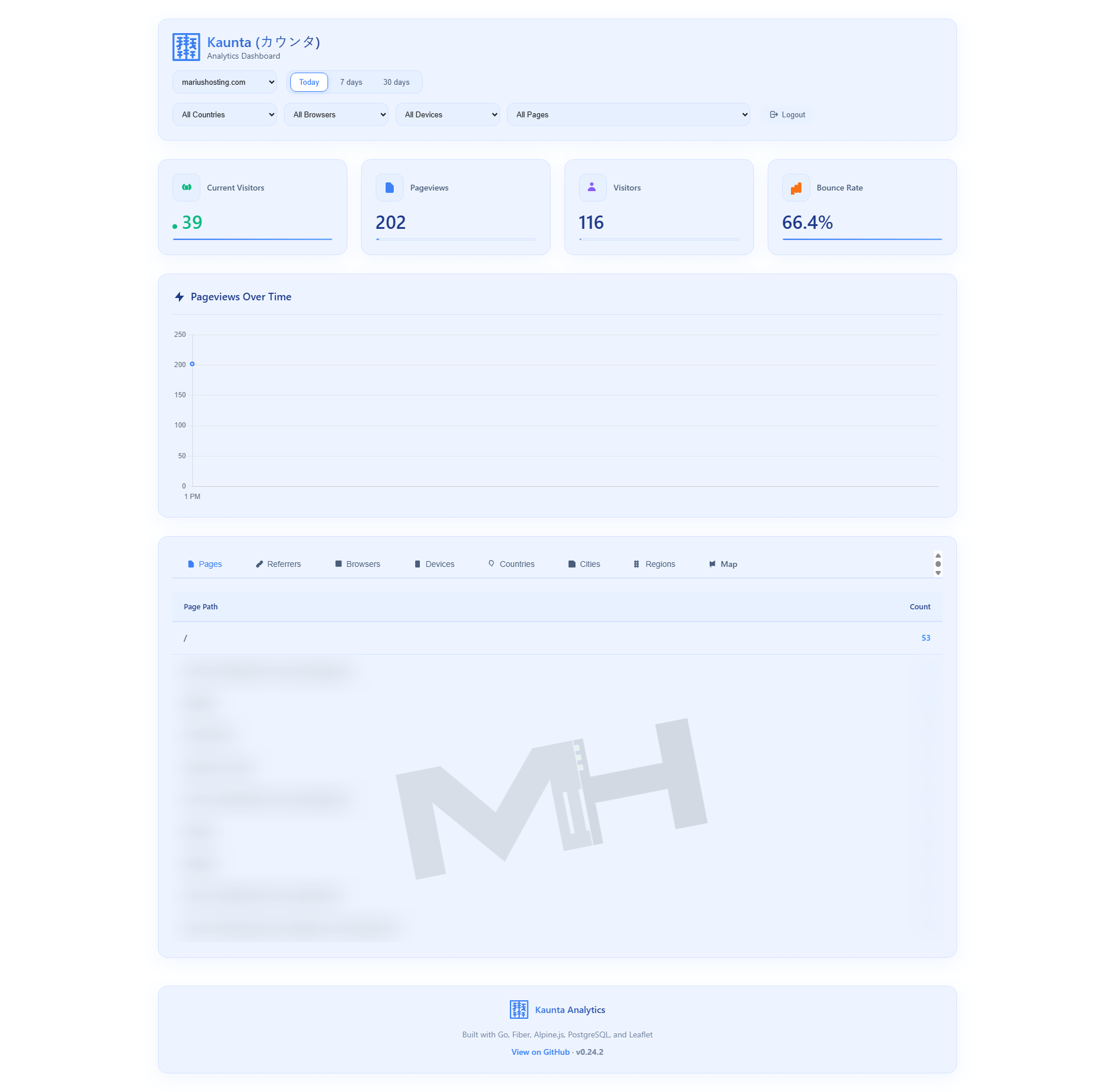
Enjoy Kaunta!
If you encounter issues by using this container, make sure to check out the Common Docker issues article.
Note: Find out how to update the Kaunta container with the latest image.
Note: How to Back Up Docker Containers on your Synology NAS.
Note: Can I run Docker on my Synology NAS? See the supported models.
Note: How to Free Disk Space on Your NAS if You Run Docker.
Note: How to Schedule Start & Stop For Docker Containers.
Note: How to Activate Email Notifications.
Note: How to Add Access Control Profile on Your NAS.
Note: How to Change Docker Containers Restart Policy.
Note: How to Use Docker Containers With VPN.
Note: Convert Docker Run Into Docker Compose.
Note: How to Clean Docker.
Note: How to Clean Docker Automatically.
Note: Best Practices When Using Docker and DDNS.
Note: Some Docker Containers Need WebSocket.
Note: Find out the Best NAS Models For Docker.
Note: Activate Gmail SMTP For Docker Containers.
This post was updated on Saturday / December 13th, 2025 at 8:56 PM
